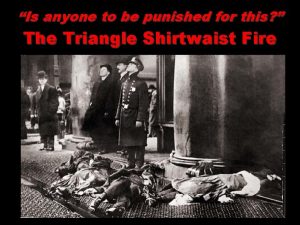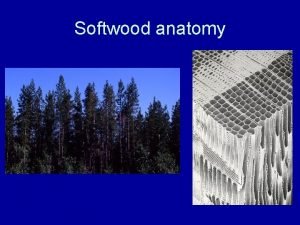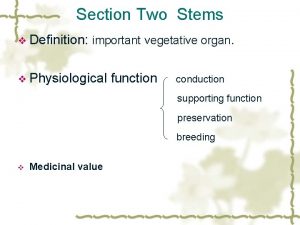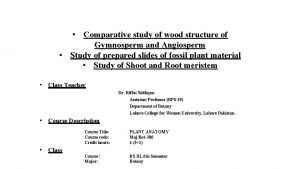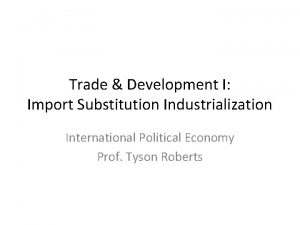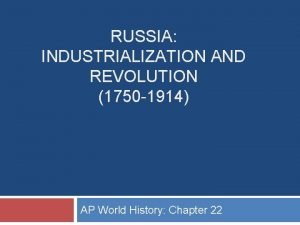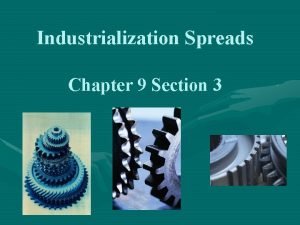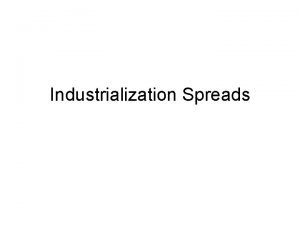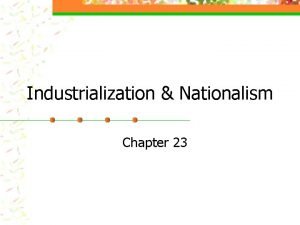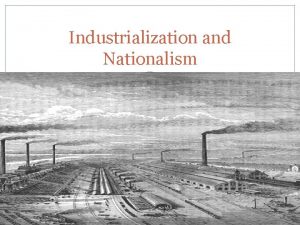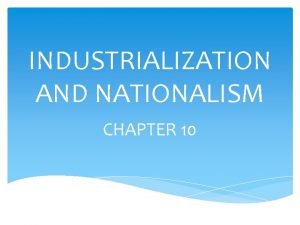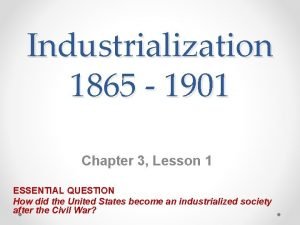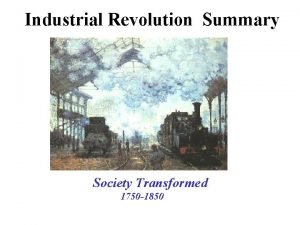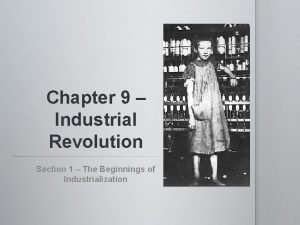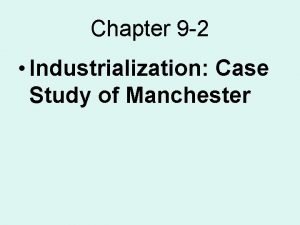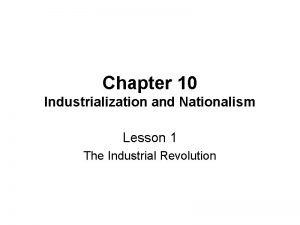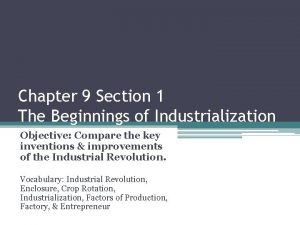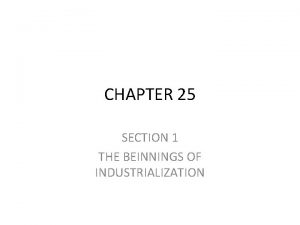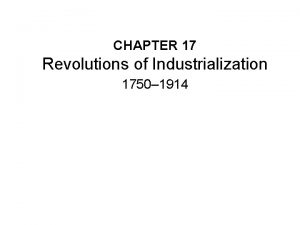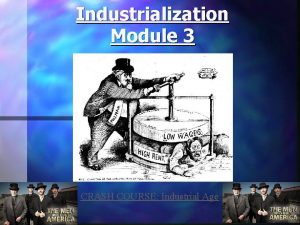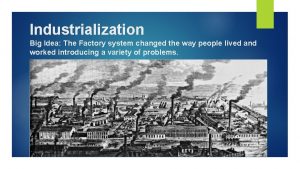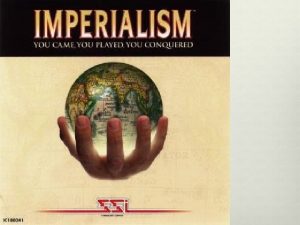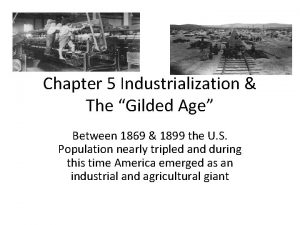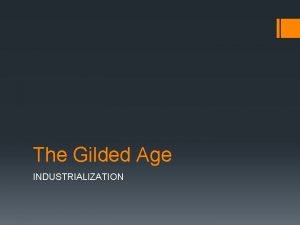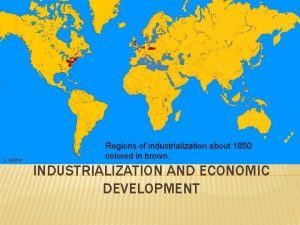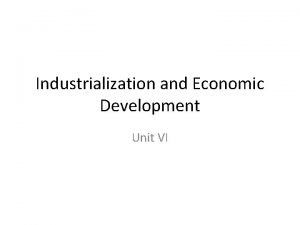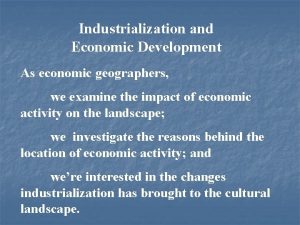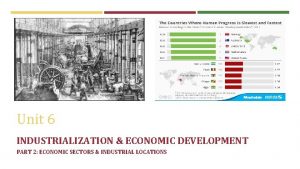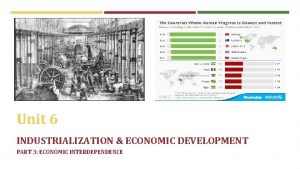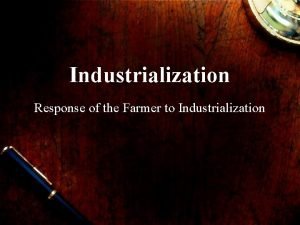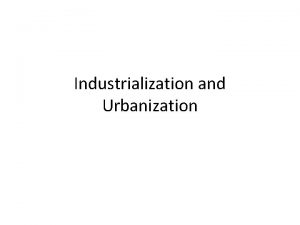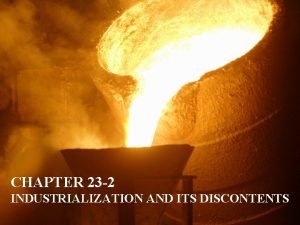Industrialization Economic Development Ethel Wood Economic Development O




































- Slides: 36

Industrialization & Economic Development Ethel Wood

Economic Development O Primary sector (agriculture) O Secondary sector (industry) – economy focuses on factories and machinery O Tertiary sector (services) O Post-industrial societies – dominated by this sector but grow through industrialization O Quaternary sector – service jobs that deal with research and development, management and admin, processing and dissemination of info

Evolution of Economics O MDCs – those that have experiences industrialization O LDCs – those that have not experienced it O NICs – Latin American and Asian countries O South Korea O Compressed modernity – rapid economic growth

Economic Indicators O GDP per Capita O Exceeds $20, 000 in MDCs, $1, 000 in LDCs O Types of Jobs O Fewest workers in primary activity (MDC) O Large % in primary activity (LDC) O Worker Productivity O MDC – more productive worker O LDC – less productive – rely on human and animal O Value added is much lower than in LDCs O Access to raw materials O Coal needed to industrialize in Europe and motivated them to control raw materials elsewhere O Availability of consumer goods O Discretionary income vs no discretionary income

Modernization Model O Westernization Model – Britain was the first and was spurred by a combination of prosperity, trade connections, inventions, and natural resources (namely coal). O Greatest barrier to this theory – tradition – O Those countries or societies unwilling to change and adapt to more modern techniques will not increase their economic development (strong family systems, ties to the past)

Dependency Theory O Economic development for many countries is blocked by the industrialized nations that exploit them O Roots in colonialism O Outgrowth of Marxism O Nationalizing industries in LDCs so they can narrow the gap between rich and poor

Modernization Theory O Rostow’s Stages of development O Traditional Stage – traditional societies O Take-off stage – Trade starts to happen, goods produced for more than just themselves, urbanization increases O Drive to technological maturity – focus on attaining higher living standards, more urbanized, local community feeling takes a back seat to economic growth O High Mass Consumption – mass production, mass consumption

Critics of theory say… O Socialist countries criticize theory bc it “justifies capitalism” and encourages exploitation of non-capitalist countries O Modernization simply hasn’t occurred in many countries O Rich nation that benefit from the status quo often block paths to development. O Difference between 19 th century development and now.

Dependency Theory O Wallerstein’s World Systems Theory: 1974 O O (capitalist world economy explanation) Based his theory on high-income nations with market economies Traced to colonial era where advantage was taken of the wealth in periphery countries Core-Semi-periphery-Periphery Dependency comes from narrow exportoriented products like oil, coffee, fruit O Countries lack industrial capacity – sell inexpensive raw materials and buy manufactured goods

Critics of this theory say… O Dependency theory wrongly treats wealth as a bad thing that no one can get richer while all other get poorer O Too much blame on rich countries O Ignoring strong cultural factors in developing nations O Corrupt national leaders

Self-Sufficiency Model O Isolate business from trade and encourage internal growth O Countries may set limits on imported goods (high taxes or set quotas) O India used this model O No incentive to improve quality with no competition or improve production costs, reduce prices

In contrast to India O Asian Tigers (Hong Kong, Taiwan, South Korea, and Singapore) – export-oriented industrialization O Product life cycle – O Innovator country comes up with the something new and then move on to other things O Other countries think of ways to make the first item better and cheaper and import that item back to the innovator country. (i. e. automobiles & electronics)

Industrial Revolution O So Why Britain? O Series of invention O Stable government O Wealth from overseas ventures O Abundant supply of coal O All helped spread the new technologies to transportation (train) and communications O Comparative advantage O Skilled laborers, established trade routes, abundant raw materials

Why then the US? O Abundant resources O Land space available O Knowledge from the old country (Samuel O O Slater built first textile mill in Rhode Island in 1791) Embargos on European imports helped spur economic growth Before 1860 – food and lumber – afterwards steel and iron Despite lack of raw materials in NE U. S. – there was an abundance of consumption of goods which helped the region grow. New York – became break-of-bulk point

A shift happens… O Early IR – coal and steel O 20 th Century IR – oil and natural gas O Power plants, machinery, cars, airplanes, & ships O Heating homes, hot water and cooking stoves O Europe and Us start to turn to other countries for these resources (SA, Kuwait, Iran, Russia, China, Mexico, Venezuela and Nigeria) O Allowed for multinational corporations within their borders

Location Theory O Primary industry – location near raw materials O Secondary Industry – O Variable costs – less expensive in some areas than others O Friction of distance – cost goes up the farther the distance of transport from source to factory O Distance decay – further away it gets the less likely it is to do business (Wallerstein’s World Systems Theory in a nutshell) Happens at a global scale and regional scale (India, U. S. )

Weber’s Least Cost Theory 1909 O Often compared to Von Thunen’s agricultural Model O Transportation – cost of inputs to factory and outputs to market – look for the least distance O Truck is cheapest for short distances, RR for medium and ships for longest O Terminal costs – least expensive for trucks, most expensive for ships (passage through the Suez or Panama canals for ex. )

Least Cost Theory cont. ’d) O Labor – cheap labor can make up for transportation costs O Agglomeration – talents, workers and facilities. O Restaurants - furniture, and equipment companies that provide business for them O Workers – need clothes – clothing stores, etc. O Deglomeration – exodus from a crowded area

And of course the Critics chime in… O Too inflexible – no consideration of costs over time O Substitution principle – juggling expenses as long as they don’t all go up at the same time

Locational Interdependence Theory (yet another location theory) O Not concerned with variable costs like Weber O Concerned with variable revenue analysis – ability to capture a market that will earn it more customers and money than its competitors O Harold Hotelling – Ice cream vendor example

Contemporary Things to Consider… O Space-time compression – “every country’s industrial development is related to conditions in the global economy” O Situation and site factors are still important – globalization has altered the meaning O Infrastructure plays a key role in decisions as to where to locate industries.

Western & Central Europe O Ruhr River area of Germany post WWI O Greatest Industrial complex O Proximity to markets, accessible transportation and natural resources O WWII – much was destroyed but was built back with the aid of US post WWII

North America O US emerged after WWI & WWII as world’s strongest industrial power O Manufacturing belt that included Canada (Windsor, Toronto, Montreal) O 20 th century manufacturing regions


Russia & Former Soviet Republics O Ukraine - grew into one of the world’s largest manufacturing complexes by 1950 s O Moscow, Leningrad O Communism controlled the development but patterns still followed logical based on geography O Dams for hydro power O Canals linked Volga to Moscow O Trans-Siberian RR

Eastern Asia O Japan – Meiji Restoration (oligarchs), Kanto Plain O Four Asian Tigers – export-oriented industrialization O China – Northeast District

Secondary Industrial Regions O Southeast Asia – Thailand, Malaysia, Indonesia, Vietnam (sphere of influence from China) O Northern Africa – Cairo, Egypt O Southern Africa – Johannesburg O Western Hemisphere – Mexico (Mexico City to Guadalajara) and Brazil (Sao Paulo, Rio to Belo Horizonte)

Eastern Asia O Japan – O Out of the way from imperialist powers O Never colonized O Later half of the 19 C (Meiji Restoration) – govt. sponsored campaign for modernization and colonization (oligarchs) O Organized armed forces O Transformed education and transportation (to follow Western model) O Established colonies for raw materials O Kanto Plain – dominant industrial region O Chosen to be near the decision makers in Tokyo

Four “Tigers” O South Korea, Taiwan, Hong Kong – (transferred power from Britain to China in 1997) & Singapore O Export – oriented industrialization O Product Life Cycle – innovator countries

China O mid-20 th Century O Began under Soviet planners & under Communist Party esp. since 1979 O Northeast District – earliest heartland of industry (Manchuria) – coal and iron (Shenyang) O Now challenging Japan for E & P leadership in the region. O Special Economic Zones (SEZs)

Secondary Industrial Regions O Southeast Asia (China’s sphere) O Northern Africa (Cairo) O Johannesburg, South Africa O Mexico (Mexico City to Guadalajara)and Brazil (Sao Paulo, Rio and Belo Horizonte)

NAFTA O Signed in 1995 O maquiladora O New international division of labor O Criticisms – US companies accused of avoiding employment and environmental regulations by using maquiladoras (assembly intensive)

India’s prospects O Large labor force O Hydro power potential O Large coal and iron ore deposits O Geographical location midway between Europe and the Pacific Rim O Computer software development (Bangalore & Hyderabad) O Call centers – developed a strong tertiary sectory

Trading Blocs O NA – NAFTA O European Union O East Asia O Closer integration within blocs but increased barriers between blocs (quotas on imports, etc. ) O Transnational corporations – operate outside of where they are headquartered O Conglomerate corporations – made up of many small firms to support the overall industry O Disparities within trade blocs are problematic Greece

Deindustrialization O Industry decrease in jobs usually means an increase in tertiary sector jobs O Should it be a concern?

Environment O Fossil fuels O Proven reserves O Potential reserves O Global warming O Acid rain
 Harriet josephine terry
Harriet josephine terry Ethel monick
Ethel monick The curious savage quotes
The curious savage quotes Ufic cpt
Ufic cpt Cross field pits
Cross field pits Early wood and late wood difference
Early wood and late wood difference Gymnosperm structure
Gymnosperm structure Wood sawed wood old tongue twister
Wood sawed wood old tongue twister Wood wood teenager
Wood wood teenager Economic growth vs economic development
Economic growth vs economic development Economic growth and development
Economic growth and development Import substitution industrialization
Import substitution industrialization Industrialization definition
Industrialization definition Duma definition ap world history
Duma definition ap world history Weber's least cost theory
Weber's least cost theory Industrialization spreads chapter 25 section 3
Industrialization spreads chapter 25 section 3 Chapter 9 section 3 industrialization spreads answer key
Chapter 9 section 3 industrialization spreads answer key Chapter 9 section 3 industrialization spreads answer key
Chapter 9 section 3 industrialization spreads answer key Industrialization and nationalism
Industrialization and nationalism Examples of footloose industry
Examples of footloose industry Chapter 10 lesson 1 the industrial revolution
Chapter 10 lesson 1 the industrial revolution -have strength to match the growth of industrialization
-have strength to match the growth of industrialization Lesson 1 the rise of industry
Lesson 1 the rise of industry Result of industrialization
Result of industrialization Immigration essential questions
Immigration essential questions Power loom industrial revolution
Power loom industrial revolution Industrialization case study manchester answer key
Industrialization case study manchester answer key Chapter 10 lesson 1 the industrial revolution
Chapter 10 lesson 1 the industrial revolution The beginnings of industrialization
The beginnings of industrialization The beginning of industrialization chapter 9 section 1
The beginning of industrialization chapter 9 section 1 Chapter 25 section 2 industrialization
Chapter 25 section 2 industrialization Chapter 17 revolutions of industrialization
Chapter 17 revolutions of industrialization Industrialization crash course
Industrialization crash course Whats the definition of industrialization
Whats the definition of industrialization Under imperialism the stronger nation attempts to
Under imperialism the stronger nation attempts to Lesson 5 - industrialization
Lesson 5 - industrialization Whats the definition of industrialization
Whats the definition of industrialization

